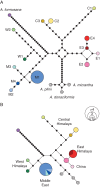Origin of the invasive Arundo donax (Poaceae): a trans-Asian expedition in herbaria
- PMID: 25081517
- PMCID: PMC4204670
- DOI: 10.1093/aob/mcu143
Origin of the invasive Arundo donax (Poaceae): a trans-Asian expedition in herbaria
Abstract
Background and aims: The hypothesis of an ancient introduction, i.e. archaeophyte origin, is one of the most challenging questions in phylogeography. Arundo donax (Poaceae) is currently considered to be one of the worst invasive species globally, but it has also been widely utilzed by man across Eurasia for millennia. Despite a lack of phylogenetic data, recent literature has often speculated on its introduction to the Mediterranean region.
Methods: This study tests the hypothesis of its ancient introduction from Asia to the Mediterranean by using plastid DNA sequencing and morphometric analysis on 127 herbarium specimens collected across sub-tropical Eurasia. In addition, a bioclimatic species distribution model calibrated on 1221 Mediterranean localities was used to identify similar ecological niches in Asia.
Key results: Despite analysis of several plastid DNA hypervariable sites and the identification of 13 haplotypes, A. donax was represented by a single haplotype from the Mediterranean to the Middle East. This haplotype is shared with invasive samples worldwide, and its nearest phylogenetic relatives are located in the Middle East. Morphometric data characterized this invasive clone by a robust morphotype distinguishable from all other Asian samples. The ecological niche modelling designated the southern Caspian Sea, southern Iran and the Indus Valley as the most suitable regions of origin in Asia for the invasive clone of A. donax.
Conclusions: Using an integrative approach, an ancient dispersion of this robust, polyploid and non-fruiting clone is hypothesized from the Middle East to the west, leading to its invasion throughout the Mediterranean Basin.
Keywords: Arundo donax; Asia; Mediterranean; Poaceae; archaeophyte; clonal species; crops; domesticated species; giant cane; giant reed; herbarium specimens; invasive species; morphometry; phylogeography.
© The Author 2014. Published by Oxford University Press on behalf of the Annals of Botany Company. All rights reserved. For Permissions, please email: journals.permissions@oup.com.
Figures




References
-
- Ahmad R, Liow PS, Spencer DF, Jasieniuk M. Molecular evidence for a single genetic clone of invasive Arundo donax in the United States. Aquatic Botany. 2008;88:113–120.
-
- Arroyo-García R, Ruiz-García L, Bolling L, et al. Multiple origins of cultivated grapevine (Vitis vinifera L. ssp. sativa) based on chloroplast DNA polymorphisms. Molecular Ecology. 2006;15:3707–3714. - PubMed
-
- Balogh E, Herr JM, Jr, Czakó M, Márton L. Defective development of male and female gametophytes in Arundo donax L. (Poaceae) Biomass and Bioenergy. 2012;45:265–269.
-
- Bandelt HJ, Forster P, Röhl A. Median-joining networks for inferring intraspecific phylogenies. Molecular Biology and Evolution. 1999;16:37–48. - PubMed
-
- Baumel A, Ainouche ML, Levasseur JE. Molecular investigations in populations of Spartina anglica C.E. Hubbard (Poaceae) invading coastal Brittany (France) Molecular Ecology. 2001;10:1689–1701. - PubMed
Publication types
MeSH terms
Substances
Associated data
- Actions
- Actions
- Actions
- Actions
- Actions
- Actions
- Actions
- Actions
- Actions
- Actions
- Actions
- Actions
- Actions
- Actions
- Actions
- Actions
- Actions
- Actions
- Actions
- Actions
- Actions
- Actions
- Actions
- Actions
- Actions
- Actions
- Actions
- Actions
- Actions
- Actions
- Actions
- Actions
- Actions
- Actions
- Actions
LinkOut - more resources
Full Text Sources
Other Literature Sources

